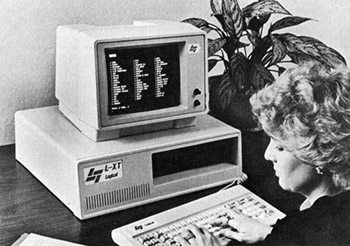
The L-XT was the last computer released by Logical Business Machines, after the Adam, the David, the Tina and the Goliath in 1982. It was announced at the 1983 COMDEX Fall in Las Vegas, and commercially available in March 1984.
The L-XT uses a 16-bit Intel 8088 CPU with 192KB RAM, and equipped with a 5.25'' floppy drive unit (320 KB capacity) and a 10 MB hard disk (upgradable to 60 MB). Two IBM expansion slots are available to the user, and the system includes one parallel and two serial ports for attaching printers, modems and other peripherals.
The Logical L-XT system could be expanded with an additional 20, 40 or 60 MB hard disk and 128 KB of additional RAM (for a total of 320 KB). Other options include memory protection from power failure, streaming tape backup, clock and calendar, and additional parallel and serial ports to accomodate printers, modems and other devices. The main difference with its brothers (Adam, Tina, David) is that it can MS-DOS, being powered by an Intel 8088 CPU.
But the most original feature of the L-XT is its Logical Natural Language called Diplomat, which was developed by Lomac since 1974 and already available on previous Lomac systems !
Logical Business Machines was an american company based in Sunnyvale, California. It was founded by John Peers, prior to buying ‘The Byte Shop’, one of the first successful chains of personal computer stores. His studies in human learning in the 70s led him to a neurological emulations approach in computing, now better-known as neural networking technology. In 1982, Mr. Peers also founded Novix, Inc., specializing in the design of high-speed microprocessors and software optimized for neural and massive parallel computing. John McAfee was vice President of engineering at Logical (at least in 1983/1984). David Chambers was hired to do work on the L-XT ROM BIOS.
This historical background is necessary to explain why Logical computers were so special. The philosophy behind the natural language operating system, is that the user is not necessarily a computer expert. Thus the system let the user create its own language based on verbs, words, nouns, numbers or expressions. Verbs call actions for example and can be used to create and index files, manipulate data, prompts the user to enter data, while nouns represent the user's data. Thus the user communicate with the computer via a "natural" language conceived by the user itself. A standard vocabulary of 46 verbes are integral to the language. Users can define others as needed. It's difficult to explain how it works, but the concept was revolutionary at the time. This natural language was the predecessor of PRAGMA (that is still used today).
Logical Business Machines shipped 175 in first month of production. Sadly, these computers and their concept didn't sell well and very little is known about them. Any testimonies or memories are welcome !
|









